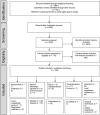PROSPECT guideline for tonsillectomy: systematic review and procedure-specific postoperative pain management recommendations
- PMID: 33201518
- PMCID: PMC8247026
- DOI: 10.1111/anae.15299
PROSPECT guideline for tonsillectomy: systematic review and procedure-specific postoperative pain management recommendations
Abstract
Tonsillectomy is one of the most frequently performed surgical procedures; however, pain management remains challenging. Procedure-specific efficacy as well as specific risks of treatment options should guide selection of pain management protocols based on evidence and should optimise analgesia without harm. The aims of this systematic review were to evaluate the available literature and develop recommendations for optimal pain management after tonsillectomy. A systematic review utilising preferred reporting items for systematic reviews and meta-analysis guidelines with procedure-specific postoperative pain management (PROSPECT) methodology was undertaken. Randomised controlled trials published in the English language up to November 2019 assessing postoperative pain using analgesic, anaesthetic or surgical interventions were identified. Out of the 719 potentially eligible studies identified, 226 randomised controlled trials met the inclusion criteria, excluding the studies examining surgical techniques. Pre-operative and intra-operative interventions that improved postoperative pain were paracetamol; non-steroidal anti-inflammatory drugs; intravenous dexamethasone; ketamine (only assessed in children); gabapentinoids; dexmedetomidine; honey; and acupuncture. Inconsistent evidence was found for local anaesthetic infiltration; antibiotics; and magnesium sulphate. Limited evidence was found for clonidine. The analgesic regimen for tonsillectomy should include paracetamol; non-steroidal anti-inflammatory drugs; and intravenous dexamethasone, with opioids as rescue analgesics. Analgesic adjuncts such as intra-operative and postoperative acupuncture as well as postoperative honey are also recommended. Ketamine (only for children); dexmedetomidine; or gabapentinoids may be considered when some of the first-line analgesics are contra-indicated. Further randomised controlled trials are required to define risk and combination of drugs most effective for postoperative pain relief after tonsillectomy.
Keywords: analgesia; evidence-based medicine; pain; systematic review; tonsillectomy.
© 2020 The Authors. Anaesthesia published by John Wiley & Sons Ltd on behalf of Association of Anaesthetists.
Figures
References
-
- Gerbershagen HJ, Aduckathil S, van Wijck AJM, Peelen LM, Kalkman CJ, Meissner W. Pain intensity on the first day after surgery. Anesthesiology 2013; 118: 934–44. - PubMed
-
- Persino PR, Saleh L, Walner DL. Pain control following tonsillectomy in children: a survey of patients. International Journal of Pediatric Otorhinolaryngology 2017; 103: 76–9. - PubMed
-
- Ericsson E, Brattvvall M, Lundeberg S. Swedish guidelines for the treatment of pain in tonsil surgery in pediatric patients up to 18 years. International Journal of Pediatric Otorhinolaryngology 2015; 79: 443–50. - PubMed
-
- Paganelli A, Khalfallah SA, Brunaud A, et al. Guidelines (short version) of the French Oto‐Rhino‐Laryngology ‐ Head and Neck Surgery Society (SFORL) for the management of post‐tonsillectomy pain in adults. European Annals of Otorhinolaryngology‐Head and Neck Diseases 2014; 131: 227–32. - PubMed
Publication types
MeSH terms
Substances
LinkOut - more resources
Full Text Sources
Medical
Miscellaneous


